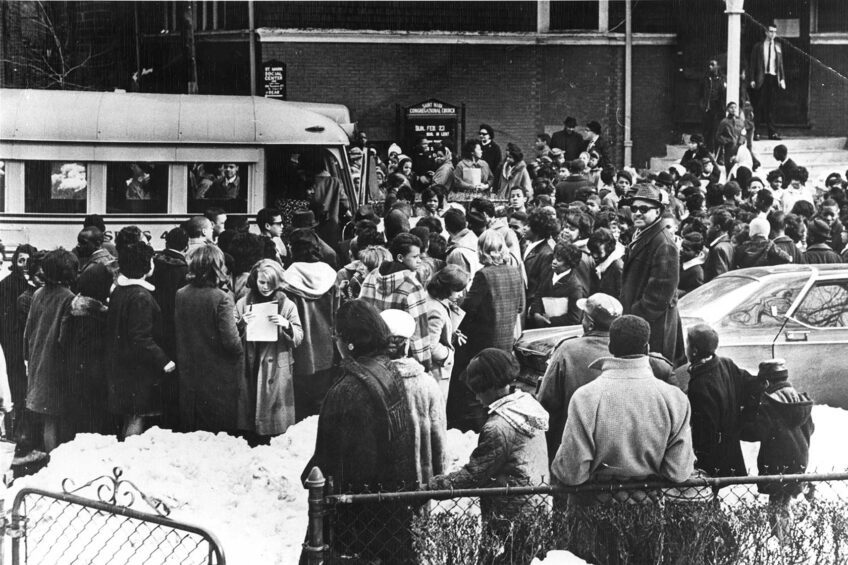Boston blacks made exodus to Roxbury
Small Beacon Hill community moved to south neighborhoods
When fugitive slaves made their way to Boston in the 18th century, their destination would likely have been Beacon Hill. The fugitives did not go there to lobby the state Legislature to abolish slavery, but rather to live in what was then Boston’s black community on the North Slope.
Beacon Hill roots
Since the black community first coalesced on Beacon Hill in the late 18th century, blacks began a pattern of moving into neighborhoods abandoned by the white gentry. At the time, wealthy whites who had employed blacks as servants on Beacon Hill began moving off the Boston peninsula to outlying communities in the town of Roxbury, where they built country estates.
The small population of free blacks working as sailors, skilled craftsmen and servants was steadily augmented by a trickle of freed and escaped slaves who sought the freedom of the North.
The African Meeting House stands as a monument to the city’s small but active 19th-century black population. Built in 1806 by free blacks, it still serves as a gathering place for Boston’s black community.
The South End
By the early 1900s, Boston’s black community had begun its move from Beacon Hill to the South End/Lower Roxbury, then a mixed-race, largely immigrant community. In the South End, blacks from the South and the West Indies continued to migrate to Boston in increasingly large numbers. In the 1930s and ’40s, blacks also began to move into the “hill” section of Roxbury, between Warren Street, Walnut Avenue and Seaver Street.
The black population stayed at less than 3 percent of the city in the first half of the century, but as the black migration North continued, the numbers began inching up. When the Banner was founded in 1965, the community was in the midst of the demographic changes that shaped its boundaries for the next two decades.
Volatile ’70s
By 1970, blacks seeking opportunity and relief from Jim Crow in Boston had swelled to 104,685, comprising 16 percent of the city’s population. The southerners and other new arrivals now dwarfed Boston’s indigenous black population.
By 1970, the borders of the black community had spread South to Franklin Field, creating a contiguous area at least 75 percent black that extended north to Columbus Avenue and Berkeley Street and as far East as the Conrail tracks in Dorchester.
Several factors served to accelerate the expansion of the black community south into Dorchester and Mattapan in the late ’60s and ’70s. First, aggressive block-busting real estate agents persuaded many blacks to purchase homes in the area using low-interest Federal Housing Authority loans. Jewish residents of the area fled to the suburbs.
Then in the ’70s, court-ordered busing accelerated the process of white flight. In the first half of the century, blacks had lived alongside ethnic whites in the South End and Lower Roxbury in a mixed neighborhood. But in the ’60s and ’70s, the accelerated integration of the historically white enclaves in Dorchester and Mattapan coupled with busing led to a Balkanization of the city. As whites left areas that then turned black, blacks too abandoned white strongholds. The 1970 census showed 388 blacks living in the South Boston area. By 1980, there were only 15. Similar retreats occurred in Charlestown and East Boston.
In the ’70s and early ’80s, many blacks were displaced from the South End as that neighborhood went through a period of gentrification. The black population there declined from 11,000 in 1970 to just under 9,000 in 1980.
In the same period elsewhere in the city, racial attacks and skirmishes were frequent, particularly in areas where blacks and whites lived in close proximity. Race riots in the Columbia Point projects underscored the difficulty of integrating public housing developments. Through the late ’80s, headline-grabbing racial incidents including the 1982 William Atkinson murder confirmed Boston’s image as a racist city. During that time, blacks moving into white sections of Dorchester faced harassment and violence.
Housing barriers come down
While blacks continued to expand into the city’s neighborhoods throughout the ’80s, many barriers existed. A 1985 Boston Fair Housing Commission study found that blacks, Hispanics and Southeast Asians seeking housing were routinely discriminated against in Dorchester and Allston-Brighton when seeking to rent or buy apartments, condominiums and houses.
More significantly, investigations by the Lawyers Committee for Civil Rights Under Law and the NAACP uncovered wide-spread discrimination in housing assignments made by the Boston Housing Authority. Blacks seeking BHA housing faced longer waits on lists for units than did their white counterparts who were concentrated in the city’s predominantly white developments.
After a year of litigation, the NAACP was able to secure a $3.8 million settlement plan for victims of past housing discrimination and the BHA began to implement a housing desegregation plan that, so far, has done more to integrate the formerly all-white strongholds of South Boston and Charlestown than any other effort before or since.
Neighborhoods
embrace diversity
While the black community in recent decades has remained concentrated in Roxbury, Dorchester, Mattapan and Hyde Park, its boundaries have lost the sharp dividing lines that defined it throughout much of the 20th century.
In contrast to the white flight of the late ’60s and early ’70s, the ongoing changes in Boston’s neighborhood reflect whites’ renewed interest in city living, and the rising wealth and income inequality in the city that cleaves along race lines.






